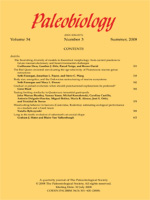Long-term diversity equilibria, ecological incumbency, and widespread recurrent fossil assemblages have each been cited as evidence that local processes, such as competition, played an important role in structuring communities over geologic time. We analyze the relationship between local and regional diversity in tropical marine communities spanning approximately 13 Myr of the Late Ordovician to test for the role of local processes in structuring local communities. We find a significant and strong positive relationship between local and regional diversity, indicating that local communities were not saturated with species and that local processes did not exert a dominant influence on local diversity. Rather, local diversity was influenced more by regional oceanographic processes that governed the size of the regional species pool. This evidence for unsaturated communities is consistent with the Walker and Valentine hierarchically structured niche model of global diversification. These results come at the beginning of the 200-Myr Paleozoic plateau in both local and global diversity and therefore raise the question whether local communities were ever saturated with species during the Paleozoic. Similar studies need to be conducted during other times in the Paleozoic to determine if this is indeed the case.
How to translate text using browser tools
1 December 2003
Lack of community saturation at the beginning of the Paleozoic plateau: the dominance of regional over local processes
Mark E. Patzkowsky,
Steven M. Holland
ACCESS THE FULL ARTICLE

Paleobiology
Vol. 29 • No. 4
December 2003
Vol. 29 • No. 4
December 2003




